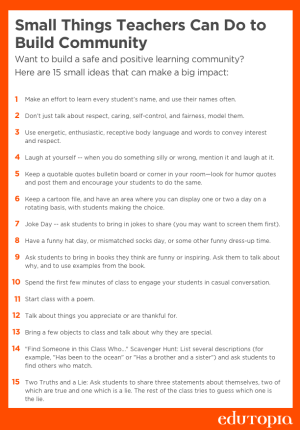4 Approaches to Building Positive Community in Any Classroom
All students want to feel part of their classroom community. Here are four activities to help them feel welcomed and comfortable.
Building positive community starts with the first day of school -- actually, it starts beforehand. You can reach out to your students with a welcome letter to let them know how excited you are for them to be in your class and what appealing projects you plan to do over the coming year.
Once they show up, students crave a sense of being a part of the community. Here are four groups of ideas to help them feel welcomed and comfortable. They are not one-shot deals. Rather, they benefit from frequent (i.e., almost daily) repetition, particularly during the first six weeks of school, and then regularly thereafter as ongoing reminders. Thanks especially to my colleagues at the Northeast Foundation for Children and PassageWorks who have thought and written about these matters extensively. Most of these ideas can be adapted to your age groups.
Getting to Know You
In small groups, have students answer one to three questions from those below -- or similar ones you create. Use a timer to give them 30-45 seconds to respond. Have groups share out one of the answers, or the most common answer. After the first round (which should have only one question to enable them to get started comfortably), help them learn how to keep track of time and to listen to what their classmates have said. Repeat other rounds over the next few days, or have students share the same things with different peers. Here are some sample questions:
- What kind of music do you like?
- If you could travel anyplace for free, where would you like to travel? Why?
- What is a place that you have visited that you like the most?
- When is your birthday?
- Where were you born?
- Who were you named after?
- Where do members of your family come from?
- What languages do they, and you, speak?
- What holidays do you enjoy, and how do you celebrate them?
- Have you ever been to a park, zoo, museum, or a farm? Pick one, and tell us about it.
- What is a movie or a book you have seen or read lately that you really liked? Why?
- If you could be any animal that you wanted as a pet, what would you pick? Why?
- If you became the principal, what is one thing you would change about this school if you could?
Take a Stand and Stand
Too often, students can be classmates, but feel disconnected from one another. Here is a way to help lower barriers. For each question, have all students stand if it is true for them. At any point, you can ask students who have areas in common to move to a spot in the room and share in more detail.
Stand up if you:
- Were born inside/outside the United States (In the north? South? East? West?)
- Were born in this state/on an island (Someplace south of here? East of here? A map will help with this one!)
- Play an instrument (Percussion? Strings? Winds?)
- Play sports (With a large ball? Small ball? Soccer?)
- Like to read (Non-fiction? History? Fiction? Mysteries? Vampire stories? Sci-fi?)
- Know a quote from a book, poem, or lyrics from music (Who is the author or composer?)
- Like pizza (What kind? With mushrooms? Pepperoni? Olives? Onions? Extra cheese? Other toppings?)
- Like to eat dessert (Cold? Hot? Sweet? Creamy? With dough? With fruit? With chocolate? With peanut butter? Anyone with food allergies?)
- Can stand on one foot for five seconds (On the other foot? For 10 seconds? Longer than that? Ask for demonstrations!)
- Like hot/cold weather (Being in the sun? Being in the rain? Thunderstorms? Windy days? Temperatures in the 90’s? In the 20’s? Anyone ever been in a tornado? Hurricane? Typhoon?)
- Know someone with a disability (Physical? Communication? Behavior? Cognitive? Other?)
- Have ever been part of a team (In school? Out of school? Music related? Sports related? Academic related? Other?)
- Have ever been to a concert/play/show/sports event indoors (Outdoors? At night? Did you sit near or far away?)
Small Things Teachers Can Do Every Day
All of these make more of a difference to students than we typically appreciate.
- Use students' names often.
- Establish shared agreements and rules with students.
- Enforce ground rules and agreements consistently with the help of students.
- Model behaviors of respect, caring, self-control, and fair decision-making.
- Use energetic, enthusiastic, and receptive body language and words to convey interest and respect.
- Use a respectful quiet down signal to gain class attention.

Be a Role Model for Positive Community
Dr. Joanne MacLennan teaches future teachers about social and emotional learning (SEL) at the College of Saint Elizabeth in New Jersey. “Probably the most powerful thing that the teacher can do right away is to model what he or she wants in terms of positivity and community, along with unconditional positive regard for each child. The other factor is a genuine passion for what the teacher is doing regarding subject matter and an understanding that his or her emotional state (expressed verbally and non-verbally) can bless or curse classroom climate.”
David Eisenstein, who teaches a general education population of urban sixth-grade students, believes in modeling plus: “In my class, the students work in groups, and points are awarded to the group for completing tasks and getting problems correct. Most importantly, points are also awarded for being polite, having good manners, and praising fellow students in class. All these positive behaviors must be modeled by me in class -- always -- so the students understand what these concepts mean and can use my examples as a template for their positive behavior.”
For those wondering about whether rewards are necessary if the modeling is powerful, David says, “I've been teaching over four decades, and I've watched the children's intrinsic motivation go down over time. The old methods aren't working as they once did, so why not use something different? Points help motivate students into a desired outcome. If not enough students are finishing their homework, then a large, 100-point bonus for all members of every group who finishes their homework may help. Points must have value. For instance, 500 points can buy a group a one-night homework pass.”
Creating a positive community can no longer be considered an option. It is essential for promoting a climate for collaborative, lasting learning.
